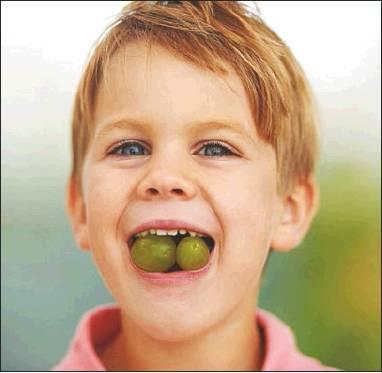Getting Into Gardening
A few weeks back my grandson mentioned how surprised he was to realize grapes could have seeds. That child’s simple comment made me wonder – how many others ever think about seedless fruits? Answering that question led to the articles about navel oranges and bananas. Today I’ll be writing about another of our seedless favorites, grapes.
If asked to name the world’s number one fruit (based on tons produced), most individuals would probably guess banana, orange or apple. While all of the previous are very important, none can rival the amount of grapes produced throughout the world. The varieties of ways in which grapes can be used coupled with the number of countries in which grapes can be grown accounts for the fact the world produces about 72 million tons of grapes annually.
Grape culture (or viticulture) is probably as old as civilization itself. Archaeological evidence suggests humans began growing grapes as early as 6500 B.C. during the Neolithic era. By 4000 B.C., grape growing extended from Transcaucasia to Asia Minor and through the Nile Delta of Egypt. King Hammurabi of Babylon probably enacted the world’s first liquor law when he established rules for wine trade in 1700 B.C.
The Hittites are credited with spreading grape culture westward as they migrated to Crete, Bosporus and Thrace, as early as 3000 B.C. Later, the Greeks and Phoenicians extended grape growing to Carthage, Sicily, southern Italy, Spain and France. Under the influence of the Romans, grape production spread throughout Europe.
At the time of the fall of the Roman Empire, grape culture and wine making primarily were associated with monasteries. Later, the use of wine extended beyond religious rites and became entrenched in culture as a social custom. This increased demand for grapes, and grape culture grew steadily from the 16th century right on until today.
The three primary uses for grapes are for wine, dried fruit (raisins) and fresh table grapes.
The world produces about 7.2 trillion gallons of wine each year, making it by far the most prevalent use of grapes. This value represents a 35% increase since the mid-20th century; Europe (Italy, France, Spain and Russia) accounts for 80% of total world production. Only about 14% of the wine produced worldwide is exported from its country of origin. Which means we all drink a lot of wine!
World-wide raisin production averages 800,000 tons per year. Since it takes about four pounds of grapes to produce one pound of raisins, the raisin industry uses about 3.2 million tons of grapes each year.
Fresh (table) grapes account for less than 12% of the world’s total grape production. Since fresh grapes are highly perishable and transportation costs high, fresh grapes are consumed primarily in the country of their production. Europe and North America lead in fresh grape consumption. The average American consumes about eight pounds of fresh grapes each year.
While that information is great, the question remains; how are we growing seedless grapes if there are no seeds to plant? Let’s answer that question.
Seedlessness or parthenocarpy occurs naturally, every once in a while when a minor mutation prevents seeds from maturing and developing a hard coat. Normally when seeds develop, they secrete a hormone called gibberellin, which encourages the fruit to grow. A small genetic error in a vine can stop gibberellin production and we end up with seedless grapes.
The Thompson seedless grape is the most common seedless table grape. It was named after William Thompson, a Scottish immigrant who promoted this variety in California during the mid-1870s. The grapes were derived from a strain called Lady de Coverly which he obtained from a nursery in New York. The nursery had gotten hold of it from others in Europe, where they had been cultivating it for over 2000 years. The story is that one day, a long time ago in a vineyard far, far away... a farmer found that one of his vines was growing a mutated grape; green not reddish, sweet to the taste, ripening early, and drying into golden raisins. It so impressed this ancient fellow that he made cuttings form that special vine and cultivated more and more of them, giving them to others to grow who passed them on to still others until today you find clones of that original bunch of grapes in supermarkets across the globe.
Over time, the cultivation of these seedless varieties became more and more sophisticated. In the 1950s, researcher at the US Agriculture Department developed the Flame – a red seedless grape that is runner-up to the Thompson in popularity.
From the 1980s, breeders have been able to remove the developing embryo seeds before they abort, through a process known as embryo rescue. These rescued seeds can be grown in petri dishes or test tubes to cross with other strains. The identification of genes for seedlessness, along with techniques for inserting genetic material directly into developing plants, has further broadened the possibilities for genetic modification. Although genetic modification through artificial selection has occurred for centuries, the more recent development of genetically modified organisms (GMOs) enables the addition of characteristics related to robustness or productivity from different species altogether. This allows for a more efficient process for selecting desirable traits, but the social and political ramifications of commercializing biological properties can be a concern. I report on this for information purposes only and not as an endorsement or condemnation of GMOs or gene manipulation.
The bottom line is that without knowledgeable farmers, seedless plants could quickly become a thing of the past. Fortunately, plants can be propagated through cuttings as has been done for thousands of years. A cutting is when you cut off a piece of plant, dip it in some rooting hormone (such as auxin, along with antibacterials), and plant it. The descendants of this process are genetically identical to the parent, which means they are clones. This works for seedless grapes, and many other plants as well. Most commercial fruit is grown from cuttings because the crop is more likely to turn out the way growers expect. The risk with this is that if something unexpected were to happen, like a disease infecting your field of identical grapes, all of your grapes will be wiped out in short order - remember Panama Disease and the Gros Michel banana?
Another way grapes and other plants, seedless or not, can be propagated is by grafting. This is where you take the cutting and stick it to another plant. They then carry on as if they were meant to be that way. This allows the characteristics of desirable fruit to be combined with a rootstock that is resistant to pests and diseases, and able to grow well under local conditions. This ability to graft onto a new rootstock saved the wine industry in both France and Later America, but that is a story for another time.



